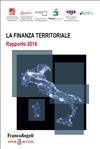
LIBRI DI LUCA GANDULLIA


Rapporto 2016
Il Rapporto 2016 affronta temi che riflettono il complesso contesto economico e istituzionale in cui si muovono oggi le Regioni italiane: dalla difficile congiuntura della finanza pubblica, ai piani di rientro per le gestioni sanitarie, dal riordino delle istituzioni del territorio alla governance del governo locale, la gestione dei fondi comunitari e le riforme nell'offerta dei servizi pubblici.
cod. 11820.5

Liber amicorum di Franco Praussello
Questo liber amicorum testimonia l’infaticabile lavoro di ricerca di Franco Praussello, economista dell’Università di Genova, che ha maturato una vasta esperienza in gruppi di ricerca italiani ed esteri affrontando temi di politica economica, economia internazionale, economia dello sviluppo ed economia dell’integrazione europea.
cod. 365.1027

cod. 500.39

cod. 365.464

cod. 365.180

cod. 365.248

This paper aims at analyzing the effects of tax incentives on Italian newly listed firms. We take into account the period between 1995 and 1998 when two kinds of tax benefits were implemented in Italy (the so called legge Tremonti and the new superDit mechanism). In order to ascertain the importance of the two kinds of benefits we simulate their effects on the effective average tax rate for the Italian newly listed firms in the period. We demonstrate that the superDit mechanism is responsible for only a small part of the tax reduction and that the total tax saving for newly listed firms depends on the new Italian tax regime starting from January 1998 and valid for all the firms (listed and not). In this sense the Tremonti benefit is a more consistent incentive to the listing process. We also discuss the general interest to favour listed firms through fiscal provisions and we characterise the two Italian benefits mentioned above from three points of view: certainty, transparency and incentive. We argue that the second and most recent tax reduction to newly listed firms, the superDit mechanism, since is permanent it is able to guarantee both the firms that have already decided to go public and the firms that will consider the listing process only in the future. In terms of transparency, however, the Tremonti provision permits a simple quantification of the tax benefit because it only consists of a tax rate reduction. On the opposite the superDit benefit depends on the firm’s capital structure, cost structure and profitability.